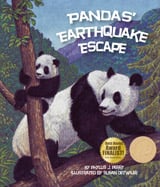Alignment to Standards for DC

| Grade | Number | Standard |
|---|---|---|
| 1 | SC.1.4. | Different types of plants and animals inhabit the Earth. |
| 2 | G 2.1.1. | Understand how maps and globes depict geographical information in different ways. (G) |
| 2 | SC.2.6. | Plants and animals have structures that serve different functions in growth, survival, and reproduction. |
| 2 | SC.2.6.1. | visible, external features of plants and animals and describe how these features help them live in different environments. |
| 2 | SC.2.7.1. | Observe and describe how animals may use plants, or even other animals, for shelter and nesting. |
| 2 | SC.2.7.4. | materials in nature, such as grass, twigs, sticks, and leaves, can be recycled and used again, sometimes in different forms, as birds do in making their nests. |
| 2 | SC.2.8. | Many different types of plants and animals inhabit the Earth. |
| 2 | SC.2.9.2. | Explain that humans, like all living things, reproduce offspring of their own kind. |
| 2 | SC.2.9.3. | Observe that and describe how offspring are very much, but never exactly, like their parents and like other offspring of the same parents. |
| 3 | SC.3.5.1. | living things can be sorted into groups in many ways using various properties, such as how they look, where they live, and how they act, in order to decide which things belong to which group. |
| 3 | SC.3.6. | Plants and animals have predictable life cycles. |
| 3 | SC.3.6.1. | Recognize that plants and animals go through predictable life cycles that include birth, growth, development, reproduction, and death. |
| 3 | SC.3.6.2. | Describe the life cycle of some living things, such as the frog and butterfly, including how they go through striking changes of body shape and function as they go through metamorphosis. |
| 3 | SC.3.6.3. | Compare and contrast how life cycles vary for different living things. |
| 3 | SC.3.7.4. | Recognize that food provides energy as well as materials for growth, maintenance, and repair of body parts. |
| 4 | SC.4.3.2. | Explain how the surface of the Earth changes over various time scales due to processes, such as erosion and weathering, landslides, volcanic eruptions, earthquakes, and mountain building. |
| 4 | SC.4.4.5. | Describe the different layers of the Earth, including the crust, mantle, and core. |
| 4 | SC.4.7.1. | Explain that organisms interact with one another in various ways, such as providing food, pollination, and seed dispersal. |
| 4 | SC.4.7.2. | Observe and recognize that some source of energy is needed for all organisms to stay alive and grow. |
| 4 | SC.4.7.7. | Explain how in all environments, organisms grow, die, and decay, as new organisms are produced by the older ones. |
| 5 | SC.5.6.1. | objects can move with a very wide range of speeds, with some moving very slowly and some moving too quickly for people to see them. |
| 5 | SC.5.8. | Many characteristics of an organism are inherited from the parents, but others result from the influence of the environment. |
| 5 | SC.5.8.2. | List some characteristics of plants and animals that are fully inherited (e.g., form of flower, shape of leaves) and others that are affected by the climate or environmental conditions (e.g., browning of leaves from too much sun, language spoken). |
| 5 | SC.5.9. | Adaptations in physical structure or behavior may improve an organismês chance for survival. |
| 5 | SC.5.9.7. | Recognize that some behaviors are instinctive (turtles burying their eggs) and others learned (wolfês hunting skills). |
| K | G K.1. 2. | Demonstrate familiarity with what a map is and what a globe is. (G) |
| K-2 | G K-2.1. | Students use map and globe skills to determine the locations of places. |